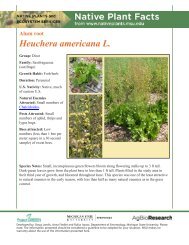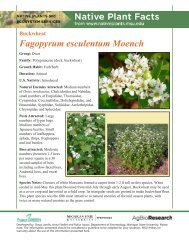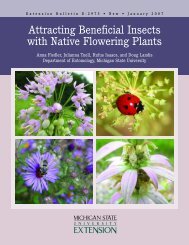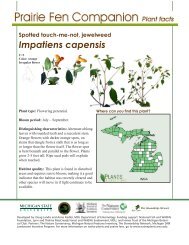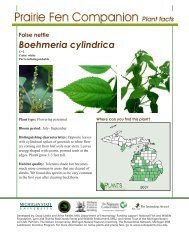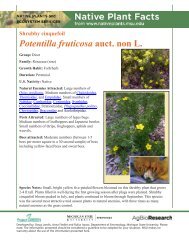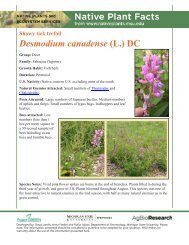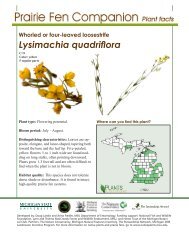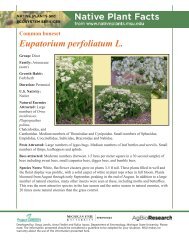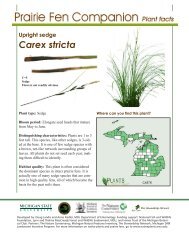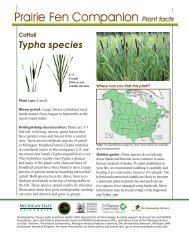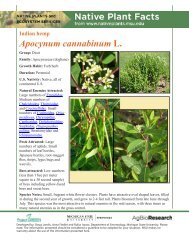New England aster - Native Plants - Michigan State University
New England aster - Native Plants - Michigan State University
New England aster - Native Plants - Michigan State University
You also want an ePaper? Increase the reach of your titles
YUMPU automatically turns print PDFs into web optimized ePapers that Google loves.
<strong>New</strong> <strong>England</strong> <strong>aster</strong><br />
Symphyotrichumnovae-angliae (L.) Nesom<br />
formerly Aster novae-angliae L.<br />
Group: Dicot<br />
Family: Asteraceae (<strong>aster</strong>)<br />
Growth Habit: Forb/herb<br />
Duration: Perennial<br />
U.S. Nativity: <strong>Native</strong><br />
Natural Enemies Attracted: Large numbers of Orius<br />
insidiousus, medium numbers of Chalcidoidea and Salticidae.<br />
Small numbers of Coccinellidae, Empididae, Cynipoidea,<br />
Ichneumonidae, Thomisidae, and Braconidae.<br />
Pests Attracted: Large<br />
numbers of Lygus bug,<br />
medium numbers of leaf<br />
beetles and small numbers of<br />
leafhoppers, thrips, Japanese<br />
beetles and weevils.<br />
Bees attracted: Moderate<br />
numbers (between 1-5 bees<br />
per meter square in a 30<br />
second sample) of bees<br />
including Andrenid bees,<br />
sweat bees, small carpenter<br />
bees, and bumble bees.<br />
Species Notes: Vibrant purple and pale violet blossoms about 3/4 inch across graced the plant during<br />
September. <strong>Plants</strong> grow to 3-5 ft tall and this species filled in fairly well in our study location. This<br />
was the eighth most attractive late season plant to natural enemies, with more than three times as<br />
many natural enemies as the grass control.<br />
Developed by: Doug Landis, Anna Fiedler and Rufus Isaacs; Department of Entomology, <strong>Michigan</strong> <strong>State</strong> <strong>University</strong>. Please<br />
note: The information presented should be considered a guideline to be adapted for your situation. MSU makes no<br />
warranty about the use of the information presented here.
About the Plant Species Graph:<br />
Average number of beneficial insects<br />
collected at each plant species the<br />
week before, during, and after peak<br />
bloom, for plant species blooming<br />
from mid-August through early<br />
October (+ standard error). <strong>New</strong><br />
<strong>England</strong> <strong>aster</strong> (Aster novae-angliae)<br />
boxed in red. Bars for natural enemies<br />
are in green, bars for bees are in<br />
yellow. Bars for native plants are solid<br />
and nonnative plants are striped. The<br />
black line on the top graph shows<br />
the number of natural enemies in<br />
grass with no flowering plants (grass<br />
control). <strong>Plants</strong> are listed in order of<br />
peak bloom.<br />
Plant Species Graph<br />
Habitat: Full sun to partial shade, and dry to fairly wet<br />
locations. Naturally occurring in areas with open ground,<br />
frequently moist to wet areas, including meadows, fields,<br />
shores, shrubby swamps, fens, wet prairies, and edges of<br />
streams and rivers. Map indicates plant distribution by state.<br />
Cultivation and Management: Can be grown from seed<br />
(flowers in second or third year) or plug material (flowers in<br />
first or second year).<br />
Availability: Species is available as seed, plug or container<br />
grown material from various native plant nurseries. See the<br />
<strong>Michigan</strong> <strong>Native</strong> Plant Producers Association<br />
For more information: View the online USDA-NRCS<br />
PLANTS database<br />
MSU is an affirmative-action, equal-opportunity employer. <strong>Michigan</strong> <strong>State</strong> <strong>University</strong> Extension programs and materials are open to all without regard to race, color, national origin,<br />
gender, gender identity, religion, age, height, weight, disability, political beliefs, sexual orientation, marital status, family status or veteran status. Issued in furtherance of MSU Extension<br />
work, acts of May 8 and June 30, 1914, in cooperation with the U.S. Department of Agriculture. Thomas G. Coon, Director, MSU Extension, East Lansing,MI 48824. This information is for<br />
educational purposes only. Reference to commercial products or trade names does not imply endorsement by MSU Extension or bias against those not mentioned.



